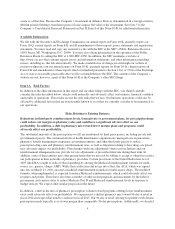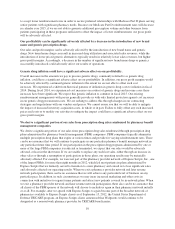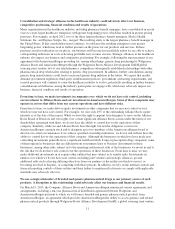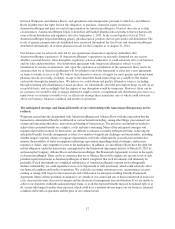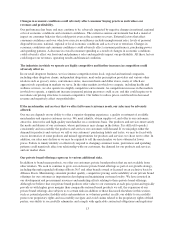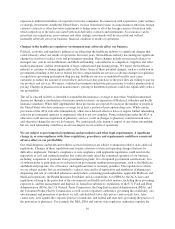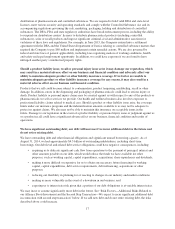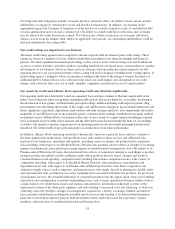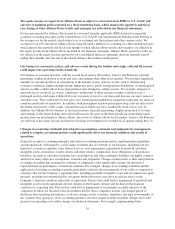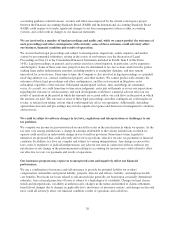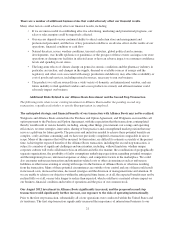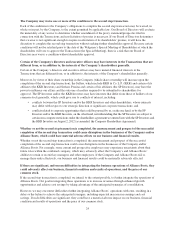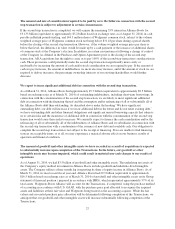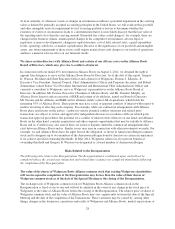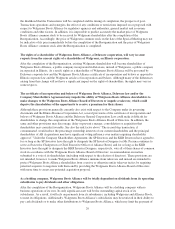Walgreens 2014 Annual Report Download - page 27
Download and view the complete annual report
Please find page 27 of the 2014 Walgreens annual report below. You can navigate through the pages in the report by either clicking on the pages listed below, or by using the keyword search tool below to find specific information within the annual report.The equity income we report from Alliance Boots is subject to conversion from IFRS to U.S. GAAP and
currency translation and is reported on a three-month lag basis, which impacts the quarterly and fiscal
year timing of when Alliance Boots results and synergies are reflected in our financial statements.
Net income reported by Alliance Boots must be converted from the applicable IFRS standards to generally
accepted accounting principles in the United States (U.S. GAAP) and translated from British pounds Sterling at
the average rate for the period, which subjects us to exchange rate fluctuations and other currency risks. We
account for our 45% interest in Alliance Boots using the equity method of accounting on a three-month lag basis,
which impacts the quarterly and fiscal year timing of when Alliance Boots results and synergies are reflected in
the equity income from Alliance Boots included in our financial statements. Alliance Boots quarterly results are
not reflected in the equity income reported in our consolidated financial statements until our quarterly period
ending three months after the end of the related Alliance Boots three-month period.
Our business is seasonal in nature, and adverse events during the holiday and cough, cold and flu seasons
could impact our operating results negatively.
Our business is seasonal in nature, with the second fiscal quarter (December, January and February) typically
generating a higher proportion of front-end sales and earnings than other fiscal quarters. We purchase significant
amounts of seasonal inventory in anticipation of the holiday season. Adverse events, such as deteriorating
economic conditions, higher unemployment, higher gas prices, public transportation disruptions, or unanticipated
adverse weather could result in lower-than-planned sales during key selling seasons. For example, frequent or
unusually heavy snowfall, ice storms, rainstorms, windstorms or other extreme weather conditions over a
prolonged period could make it difficult for our customers to travel to our stores and increase our snow removal
and other costs. This could lead to lower sales or to unanticipated markdowns, negatively impacting our financial
condition and results of operations. In addition, both prescription and non-prescription drug sales are affected by
the timing and severity of the cough, cold and flu season which can vary considerably from year to year. In
addition, the Alliance Boots business is seasonal in nature, typically generating a higher proportion of revenue
and earnings in the winter holiday and cold and flu season. Because of the three-month lag in reporting equity
income from our investment in Alliance Boots, the results of Alliance Boots for December, January and February
are reflected in the equity income included in our financial statements for our third fiscal quarter ending May 31.
Changes in accounting standards and subjective assumptions, estimates and judgments by management
related to complex accounting matters could significantly affect our financial condition and results of
operations.
Generally accepted accounting principles and related accounting pronouncements, implementation guidelines
and interpretations with regard to a wide range of matters that are relevant to our business, including, but not
limited to, revenue recognition, sales returns reserves, asset impairment, impairment of goodwill and other
intangible assets, inventories, vendor rebates and other vendor consideration, lease obligations, self-insurance
liabilities, tax matters, unclaimed property laws and litigation and other contingent liabilities are highly complex
and involve many subjective assumptions, estimates and judgments. Changes in these rules or their interpretation
or changes in underlying assumptions, estimates or judgments could significantly change our reported or
expected financial performance or financial condition. For example, changes in accounting standards and the
application of existing accounting standards particularly related to the measurement of fair value as compared to
carrying value for the Company’s reporting units, including goodwill, intangible assets and investments in equity
interests, including investments held by our equity method investees, may have an adverse effect on the
Company’s financial condition and results of operations. Factors that could lead to impairment of goodwill and
intangible assets include significant adverse changes in the business climate and declines in the financial
condition of a reporting unit. Factors that could lead to impairment of investments in equity interests of the
companies in which we invested or the investments held by those companies include a prolonged period of
decline in their operating performance or adverse changes in the economic, regulatory and legal environments of
the countries they operate in. New accounting guidance also may require systems and other changes that could
increase our operating costs and/or change our financial statements. For example, implementing future
19


